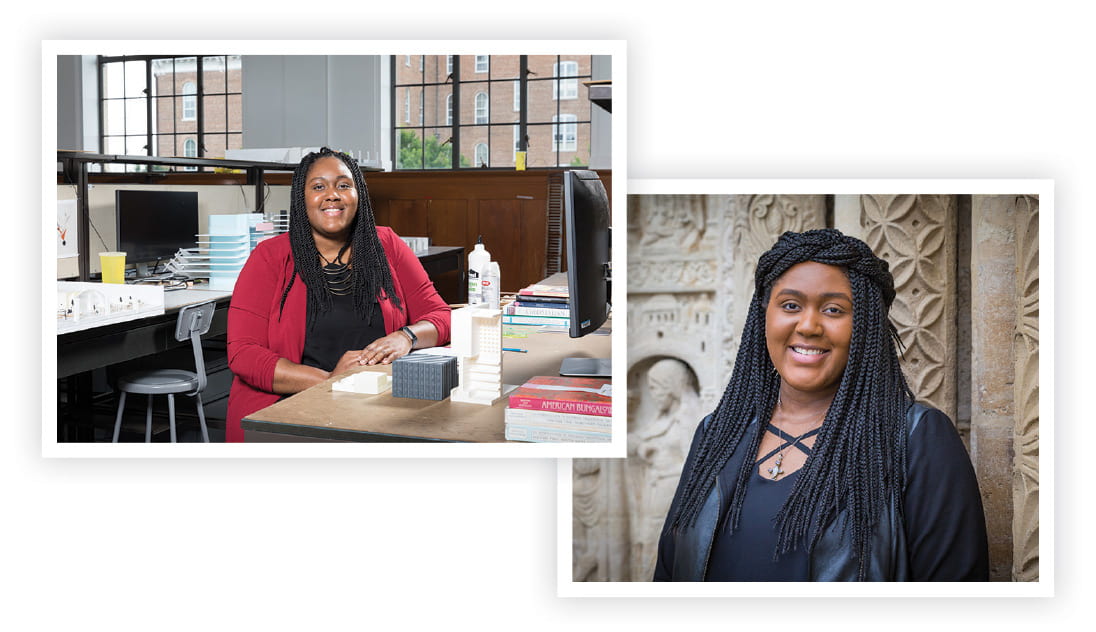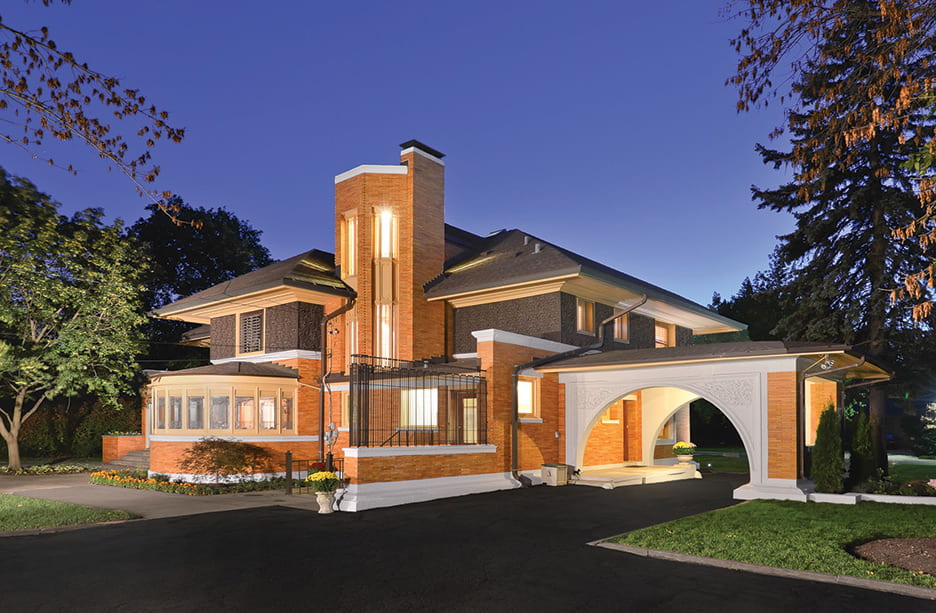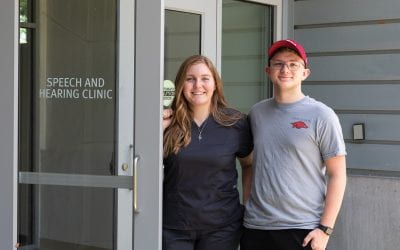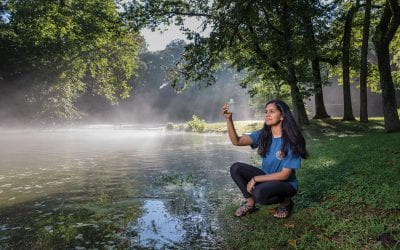Exploring National Identity By Design
By Brock DeMark
Photos courtesy of Jim Tschetter/IC360 Images and Russell Cothren
Honors architecture major Anna Ibru grew up in Lagos, Nigeria, in a neighborhood graced by many colonial-era bungalows on expansive lots. “My whole life revolved around buildings like this,” Ibru said. “They just signaled home to me.” Today, Lagosian bungalows are disappearing as developers race to replace them with high-rise apartments. “There’s only one or two bungalows that are still standing on my street,” Ibru said. “It’s very shocking to me.”

Lagos, Nigeria bungalow, photographed by H.S. Freeman, 1900-1920. Courtesy The National Archives, UK. High ceilings, large windows and wide verandas helped British colonizers adapt to humid conditions.

Anna Ibru in design studio and at the Basilica of Saint-Denis, Paris.
Study abroad in Italy, France, Spain and Japan sparked Ibru’s interest in the connection between architecture and national identity. To investigate this connection, she delved into the work of both historians and political theorists, including Benedict Anderson. In his book, Imagined Communities, Anderson extols national identity, which he terms “nationess,” as “the most universally legitimate value in the political life of our time.” Still, Ibru contends, symbols of national identity in architecture, such as the signature red brick arches of ancient Rome, predate the modern era. “Architecture has long been associated with power and identity. … It’s easy to notice a sense of pride when looking to the architecture of [a] place, be it country or region,” Ibru said.
For her honors thesis, Ibru analyzed two distinct types of architecture that played a role in national identity formation at the turn of the 20th century: Frank Lloyd Wright’s Prairie style, and the British colonial bungalow. Ibru learned about the Prairie style, which is generally characterized by horizontal lines, low roofs, and organic designs, through her mentor, professor Jeff Shannon, and a study tour of Chicago with her colleagues in the Fay Jones School of Architecture and Design. Although she was familiar with the colonial bungalow from her childhood, Ibru had to do a lot more digging before she could compare the two styles.
While architectural historians regularly discuss and publish articles on Frank Lloyd Wright’s Prairie style, little information is available on the British colonial bungalow. To find out more, Ibru sought the advice of professionals from across the country. She spoke with urban and architectural historian Itohan Osayimwese, a specialist on colonial-era architecture, at Brown University. She later tracked down professors at the University of California, Santa Barbara, and the University of Pittsburgh.
Ibru found that the colonial bungalow incorporated elements of both British nostalgia and local ingenuity. “Having to transition British ideas for building to warm, humid colonies was not something that was feasible,” Ibru said. “The climate meant that the architecture had to change.” Thus, the colonizers adopted elements of the Bangla, Southeast Asian “wayfarer house” style — including thatched roofs, tall, pitched ceilings, large windows, and wide verandas — to create a hybridized homestead that was both functional in a warm climate and reproducible in other British colonies.
Frank Lloyd Wright’s Prairie style was also a hybrid form in that it sought to compartmentalize public and private aspects of American identity. To explore national identity in Wright’s work, Ibru analyzed Winslow House, a home that Wright built in 1893-94 in the suburbs of Chicago.
The front of Winslow House — the side that faces the street — is flat and two-dimensional, while the back of the house consists of rooms and arches that protrude into the yard. According to Ibru, the front of the home coincided with “how people are expected to act in society; there’s a sense of principle [and] there’s order,” while the back of the home was geared toward the individual’s private life. With the Prairie style, “what you can do in public versus in private is translated into how a building is designed,” Ibru said.
Many of Frank Lloyd Wright’s contributions to American national identity remain intact, with Winslow House and other residences still in use as private homes and a number of buildings enshrined as public spaces. Residents of Northwest Arkansas need travel no further than Bentonville to experience Wright’s architecture, where his Bachman-Wilson House has been reassembled on the grounds of the Crystal Bridges Museum of American Art.
The British bungalows in Lagos, on the other hand, are being destroyed to make way for modern skyscrapers. “Since Nigeria is still regarded as a developing country, there’s still the quest to build it to look like first-world countries,” Ibru said. “People start to forget that as you’re trying to change things to become more developed, you have to keep some of the old. Bungalows are important to us as a people. If you destroy all of this, we lose our roots.”
Ibru is currently pursuing a master’s degree in public policy with a focus on climate change and sustainability at Northeastern University in Boston. She plans to return to Lagos in the future to help her home city preserve colonial-era architecture like the bungalows around where she grew up.
More Field Notes
Driving Innovation
Nick Foster, Lauren Horne, Colby Reed and Robbie Prettyman examine the prototype for a laser lighting system in the McMillon Innovation Studio.By Kendall CurleePhotos courtesy of Philip ThomasTruck drivers keep our economy moving and currently, they’re in short...
Band Aid
By Hiba TahirPhotos courtesy of Russell Cothren Emily Myers, a trumpet player in the Razorback Marching Band, looked around during a high school warm-up one day years ago to discover that — despite an alarmingly high decibel level that “maxed out” an app she used to...
Linking Fate + Future
By Katie Wilson PowellPhotos courtesy of Russell Cothren When it comes to politics, what impacts your opinions? When you fill out your race or ethnicity on the census, do you struggle with which box to check? These are key questions that Esmeralda Verdin Gomez...
Probing Pollution at Lake Keith
By Samantha Kirby Photos courtesy of Russell Cothren and Chieko Hara If you’ve ever traveled along Highway 112 to Northwest Arkansas National Airport, you’ve likely passed Lake Keith on your way through Cave Springs. But you can’t be faulted for not noticing: On...

Frank Lloyd Wright’s Winslow house presents a formal facade to the street, while the back embraces the homeowner’s private life. Photo at left, courtesy Jim Tschetter/IC360 Images. Rendering below, copyright ©2020 Frank Lloyd Wright Foundation, Scottsdale, AZ. All rights reserved. The Frank Lloyd Wright Foundation Archives (The Museum of Modern Art | Avery Architectural & Fine Arts Library, Columbia University, New York).





